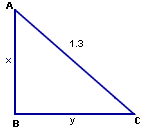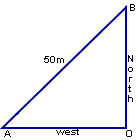How to do add fractions
We shall now discuss problems that can be solved with quadratic equations.
Consider these examples.
Example 1
The product of two consecutive numbers is 72. Find the numbers.
Solution :
Let the smaller number = x
Let the larger number = x+1
Their product = x(x+1)
We are given that
x(x + 1) = 72
⇒ x2 + x = 72
⇒ x2 + x - 72 = 0
Factorizing
x2 + 9x - 8x - 72 = 0
x(x + 9) - 8(x + 9) = 0
(x - 8) (x + 9) = 0
⇒ x - 8 = 0 or x + 9 = 0
⇒ x= 8 or x = - 9
⇒ x + 1 = 8 + 1 or x + 1 = -9 + 1
= 9 = -8
Therefore, the two consecutive numbers are 8, 9 or -9, -8
Example 2
A man walks a distance of 48 kilometers in a certain amount of time. If he increased his speed by 2 km/hr,
he would have reached his destination four hours earlier. Find his usual speed.
Solution :
Let the man's usual speed = x km/hr
Time taken to walk 48 km = (48/x) hrs
Time = Distance/Speed
Increased speed = (x + 2) km/hr
Time taken to walk 48 km =48/x+2
At a speed of (x + 2) km/hr, the man reaches his destination 4 hours earlier.

⇒ 96 = 4(x2 + 2x)
96 = 4x2+ 8x
Transposing
4x2 + 8x - 96 = 0
⇒ 4(x2 + 2x - 96) = 0
⇒ x2 + 2x - 24 = 0/4
⇒ x2+ 2x - 24 = 0
Factorizing
⇒ x2 + 6x - 4x - 24 = 0
x(x + 6) - 4 (x+6) = 0
(x - 4) (x + 6) = 0
⇒ x - 4 = 0 or x + 6 = 0
⇒ x = 4 or x = -6.
Since the man cannot walk at a negative pace, we reject x = -6
Speed = x =4km/hr
Example 3
Ann can row her boat at a speed of 5 km/hr in still water. If it takes her one hour more to row her boat 5.25 km
upstream than to return downstream, find the speed of the stream.
Speed of boat = 5 km/hr
Let the speed of the stream current = x km/hr.
Speed of the boat upstream (against the current)
= (5 - x) km/hr
Speed of the boat downstream (with the current)
= (5 + x) km/hr.
Let t1 = time taken to travel 5.25 km upstream
then t1 = 5.25/5-x since time = Distance/Speed
Let t2 = time taken to travel 5.25 km downstream then
t2 = 5.25/5+x
Now, t1 t2
Since it takes 1 hour more to travel upstream than downstream
t1 = t2 + 1

5.25 [2x] = 1(25-x2)
10.50 x = 25 - x2
Transposing
x2 + 10.5x - 25 = 0

⇒ 2x2 + 21x - 50 = 0 * 2
⇒ 2 x2 + 21x - 50 = 0
⇒ 2x2 + 25x - 4x - 50 = 0
⇒ x(2x + 25) - 2(2x + 25) = 0
⇒ (x-2) (2x + 25) = 0
⇒ x-2 = 0 or 2x + 25 = 0
⇒ x = 2 or 2x = - 25
or x=-25/2
= -12.5 km/hr.
Since the speed of the stream cannot be negative we reject
x = -12.5km/hr.
∴Speed of the stream = 2 km/hr.
Try these questions
I. To solve by completing the square
- The product of 2 numbers exceeds their sum by 14. If their sum is 10 find the numbers.
- A plan of a rectangular hall has a ground area of 180 sq.m. The plan is altered so that the length
diminishes by 3m and the breadth increases by 2m without altering the area. Find the original length
and breadth and the new length and breadth of the hall.
- A number consists of two digits, the digit in the units place is the square of the digit in the tens place.
The number formed by reversing the digits exceeds twice the number by 15. Find the number.
- Two taps when opened together can fill a cistern in 30 minutes. The larger tap takes 25 minutes less to
fill the cistern, than the smaller one. Find the time taken by each tap, to fill the cistern, separately.
- If a body is projected upward from the surface of the earth with a velocity, v, the altitude, h, reached at
any time t, is given by h=vt - 16t2 . If v = 40, h = 9 find the corresponding value of t.
- The bending moment for a certain uniform beam is given by the formula
M = 25x -(wx2/2) where M is the bending moment at a
distance of x meters from one end of the beam, and w is the weight parameter of the beam. Find how
far from the farther end is the bending moment 30 when the weight parameter is 10kg.
- A plane left 40 minutes late due to bad weather and in order to reach its destination 1600 km away in
time, it had to increase its speed by 400 km/hr from its usual speed. Find its usual speed, the time
normally taken, and the new speed.
- A piece of wire 3m long is to be bent in the form of a right angled triangle with a hypotenuse of length
1.3m. Find the lengths of the other two sides.
- A head wind reduced a cyclist's speed by 3km/hr, as a result he took 30 minutes more to travel a
distance of 30 km. What would have been his speed had there been no head wind.
- Two trains leave a railway station at the same time. The first train travels due west and the second train
due north. The first train travels 5 km/h faster than the second train. If after two hours they are 50 km
apart, find the speed of each train.
Answers
1.
1. Let the numbers be x and y
Their sum is 10
∴ x + y = 10
or y = 10 – x
The product exceeds their sum by 14
So
x (10 – x) = 10+14
⇒ 10x – x2 = 24
Transposing
x2 – 10x + 24 = 0
Factorizing
x2 – 6x – 4x + 24 = 0
x(x – 6) – 4 (x – 6) = 0
(x – 4) (x – 6) = 0
⇒x – 4 = 0 or x – 6 = 0
⇒ x = 4 or x = 6
⇒ y = 10 – x or y = 10 – x
⇒ y = 10 – 4 or y = 10 – 6
⇒ y = 6 or y = 4
∴ The number are 4, 6
2. Let the original length = l meters
Let the original breadth = b meters
Area = length * breadth
⇒ 180 = l * b
⇒ l = 180/b
In the altered plans
New length = (l – 3)meters
New breadth = (b + 2) meters
Area = (l – 3) (b + 2)
or 180 = (l – 3) (b + 2) ----------(1)

cross multiplying
180 b = 1(180 – 3b) (b + 2)
180 b = (180 – 3b)b + (180-3b)2
180 b = 180b – 3B2 + 360 – 6b
Transposing
180b – 180b + 3B2 – 360 + 6b = 0
3B2 + 6b – 360 = 0
3(B2 + 2b – 120) = 0
B2 + 2b – 120 = 0/3
B2 + 2b – 120 = 0
Factorizing
B2+ 12b – 10b – 120 = 0
b(b + 12) – 10 (b + 12) = 0
(b – 10) (b + 12) = 0
⇒ b – 10 = 0 or b + 12 = 0
⇒ b = 10 or b = - 12
The breadth cannot be negative
∴ b = 10 m.
l = 180/b
= 180/10
= 18 m.
original length = 18m
original breadth = 10m
new length = l-3 = 18-3 = 15m
new length = b+2 = 10 + 2 = 12m.
3. If we could write the 2 digit number in the form original number reversed number

Let x be the digit in the tens place then x2 is the digit in the units place.
Original number = 10 * x + x2
= 10x + x2
Twice the original number = 2(10x + x2)
Reversed number = 10 * x2 + x
= 10x2 + x
The reversed number exceeds twice the original number by 15
10x2 + x = 2(10x + x2) + 15
10x2 + x = 20x + 2x2 + 15
Transposing
10 x2 + x – 20x – 2x2 – 15 = 0
8 x2 – 19x – 15 = 0
Factorizing
8x2 –24x + 5x – 15 = 0
8x (x-3) + 5(x-3) = 0
(8x+5) (x-3) = 0
⇒ 8x + 5 = 0 or x – 3 = 0
⇒ 8x = - 5 or x = 3
⇒ x =- 5/8 or x = 3
Since a digit cannot be a rational number
x = 3
∴ x2 = (3)2 = 9
The original number = 10x + x2
= 30 + 9
= 39
4. Let the time taken by the smaller tap to fill the cistern = x minutes
Time taken by larger tap to fill the listern =(x-25 ) minutes.
In 1 minute the smaller tap fills1/x of the cistern
In 1 minute the larger tap fills 1/x-25 of the cistern.
Since it takes 30 minutes to fill the cistern. The work done by both the taps in 1 minute is

(2x – 25) * 30 = 1(x2 – 25x)
60x – 750 = x2 – 25x
Transposing
x2 –25x – 60x + 750 = 0
x2 –85x + 750 = 0
x2 –75x – 10x + 750 = 0
x(x–75) – 10 (x–75) = 0
(x-10) (x-75) = 0
⇒ x – 10 = 0 or x – 75 = 0
⇒ x = 10 or x = 75
If x = 10 mins
Then x –25 = 10-25 = -15 minutes.
Since time is not negative we reject x = 10
∴ x = 75 mins
Time taken by the smaller tap = 75 minutes
Time taken by the larger tap = 75 – 25 = 50 minutes
5. Given h= vt – 16t2 (1)
and v = 40m/s h = 9m.
Substituting in ---------------------- (1)
9 = 40t – 16t2
Transposing
9 - 40t + 16t2 = 0
16t2 – 40t + 9 = 0
Factorizing
16t2 – 36t –4t + 9 = 0
4t(4t-9) –1 (4t-9) = 0
(4t – 1) (4t – 9) = 0
⇒ 4t – 1 = 0 or 4t – 9 = 0
⇒ 4t = 1 or 4t = 9
⇒ t =1/4 or t = 9/4
⇒ t = 0.25 sec or t = 2.25 secs.
6. 
30 = 25x – 5x2
Dividing throughout by 5

Transposing
x2 – 5x + 6 = 0
x2 – 3x – 2x + 6 = 0
x (x-3) – 2(x-3) = 0
(x-2) (x-3) = 0
⇒ x – 2 = 0 or x – 3 = 0
⇒ x = 2 m or x = 3m.
Since the further end is to be obtained
x = 3m.
7. Let the planes usual speed = x km/hr.
Distance = 1600 km.
Usual time = 1600/x
Time = Distance/Speed
New speed = (x+400) km/hr.
New time = 1600/(x+400)
Since the plane is late by 40 minutes, it has to gain those 40 minutes to reach its destination on time.
∴ 1600/x =1600/(x+400) +40/60 (Minutes and seconds are generally converted into hours

Cross Multiplying
3(640000) = 2 (x2 + 400x)
⇒ 1920000 = 2x2 + 800x
Dividing both sides by 2 and transposing

x2 + 400x = 960000
x2 + 400x – 960000 = 0
x2 + 1200x – 800x – 960000 = 0
x(x+1200) – 800 (x+1200) = 0
(x-800) (x+1200) = 0
x – 800 = 0 or x + 1200 = 0
x = 800 or x = -1200
Since the speed cannot be negative
x = 800 km/hr
Time usually taken = 1600/800 = 2 hours.
New speed = x + 400
= 800 + 400
= 1200 km/hr.
8. Total length of the wire = 3m
Let ABC be the right triangle
Let AB = x
and BC = y
CA = 1.3 m
Perimeter of Δ ABC = length of wire

∴ AB + BC + CA = 3
x + y + 1.3 = 3
x + y = 3 – 1.3
x + y = 1.7
y = 1.7 - x
By Pythagoras theorem
AB2 + BC2 = CA2
x2 + y2 = (1.3)2
Substituting y = 1.7 – x
x 2 + (1.7–x)2= (1.3)2
⇒ x2 + 2.89 – 3.4x+ x2 = 1.69
Transposing
2x2 – 3.4x + 2.89 – 1.69 = 0
2 x2 – 3.4x + 1.20 = 0
2 x2 – 3.4x + 1.2 = 0
9. Let the cyclist's speed = x km/hr
Time taken to travel 30 km = Distance/Speed
= 30/x
Because of the head wind, his speed is reduced by 3 km/hr.
So his speed against the head wind = (x-3) km/hr
Time taken to travel at reduced speed = 30/x-3
Time taken is 30 minutes more than it would have been if there were no head wind.

Cross Multiplying
90*2 = 1*(x2> – 3x)
180 = x2 – 3x
Transposing
x2 –3x – 180 = 0
Factorizing
x2–15x+12x–180 = 0
x(x-15)+12(x-15) = 0
(x+12) (x-15) = 0
⇒ x+12 = 0 or x-15 = 0
⇒ x= -12 or x = 15
Since the cyclists speed cannot be negative we reject x = -12
Speed = 15 km/hr.

⇒ 20x2 – 34x + 12 = 0
⇒ 20x2 – 24x-10x + 12 = 0
4x (5x-6) –2(5x-6) = 0
⇒ (4x-2) (5x-6) = 0
⇒ 4x-2 = 0 or 5x-6 = 0
⇒ 4x = 2 or 5x = 6
⇒ x = 2/4 or x = 6/5
⇒ x = 0.5 or x = 1.2
If x = 0.5m y = 1.7-x = 1.7 – 0.5 = 1.2 m
If x = 1.2m y = 1.7-x = 1.7 – 1.2 = 0.5 m
The sides are 0.5m and 1.2m.
10. Let O be the station from which the trains start their journey. In 2 hours time the first train is at A
and the second train is at B.

Distance AB = 50 km.
Let the speed of the 2nd train = x km/hr
The speed of the 1st train = (x+5) km/hr
Distance traveled by 1st train = speed x time
In 2 hours = 2*(x+5)
= OA = (2x + 10) km
Distance travelled by the 2nd train
In 2 hours = OB = 2*x
= (2x) km.
By Pythagoras theorem in a right angled triangle
OA2 + OB2 = AB2
By Pythagoras theorem in a right angled triangle
OA2 + OB2 = AB2
(2x+10)2 + (2x)2 = (50)2
4x2 + 40x + 100 + 4x2 = 2500
Transposing.
8x2 + 40x + 100 – 2500 = 0
8x2 + 40x – 2400 = 0
Dividing through out by 8

x2 + 5x – 300 = 0
Factorizing
x2 + 20x – 15x – 300 = 0
x(x+20) – 15(x+20) = 0
⇒ x-15 = 0 or x+20 = 0
⇒ x = 15 or x = -20
Since the speed cannot be negative x =-20 is rejected
X = 15 km/hr.
First trains speed = x+5 = 15+5 = 20 km/hr.
2nd train speed = x = 15 km